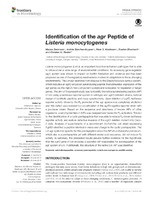Identification of the agr Peptide of Listeria monocytogenes

Date
2016Author
Zetzmann, Marion
Sánchez-Kopper, Andrés
Waidmann, Mark
Blombach, Bastian
Riede, Christian
Metadata
Show full item recordAbstract
Listeria monocytogenes (Lm) is an important food-borne human pathogen that is able
to strive under a wide range of environmental conditions. Its accessory gene regulator
(agr) system was shown to impact on biofilm formation and virulence and has been
proposed as one of the regulatory mechanisms involved in adaptation to these changing
environments. The Lm agr operon is homologous to the Staphylococcus aureus system,
which includes an agrD-encoded autoinducing peptide that stimulates expression of the
agr genes via the AgrCA two-component system and is required for regulation of target
genes. The aim of the present study was to identify the native autoinducing peptide (AIP)
of Lm using a luciferase reporter system in wildtype and agrD deficient strains, rational
design of synthetic peptides and mass spectrometry. Upon deletion of agrD, luciferase
reporter activity driven by the PII promoter of the agr operon was completely abolished
and this defect was restored by co-cultivation of the agrD-negative reporter strain with
a producer strain. Based on the sequence and structures of known AIPs of other
organisms, a set of potential Lm AIPs was designed and tested for PII-activation. This led
to the identification of a cyclic pentapeptide that was able to induce PII-driven luciferase
reporter activity and restore defective invasion of the agrD deletion mutant into Caco-
2 cells. Analysis of supernatants of a recombinant Escherichia coli strain expressing
AgrBD identified a peptide identical in mass and charge to the cyclic pentapeptide. The
Lm agr system is specific for this pentapeptide since the AIP of Lactobacillus plantarum,
which also is a pentapeptide yet with different amino acid sequence, did not induce PII
activity. In summary, the presented results provide further evidence for the hypothesis
that the agrD gene of Lm encodes a secreted AIP responsible for autoregulation
Description
Artículo científico
Source
Frontiers in MicrobiologyShare
Metrics
Collections
- Artículos [39]

